10 Beautiful Destinations in Rome First-Timers Will Love!
WanderInEurope is reader-supported. Affiliate links and ads help us keep creating useful content for you.
For people like me who live far from Italy, Rome is a once-in-a-lifetime destination. When you finally get the chance to visit, seeing the city’s most famous landmarks and stunning views feels like a must—who knows when you’ll be back?
Sound familiar? If you’re planning your first trip to Rome, I’ve got 10 recommendations to help you make the most of it. But before that, let me share one truth: Rome’s beauty comes in many forms, and its undeniable charm draws millions of tourists every year. There’s the food, the artwork, the time-transporting experiences…
But in my opinion, what really makes it unforgettable are the historic landmarks and their stunning architecture. Check out this gallery.
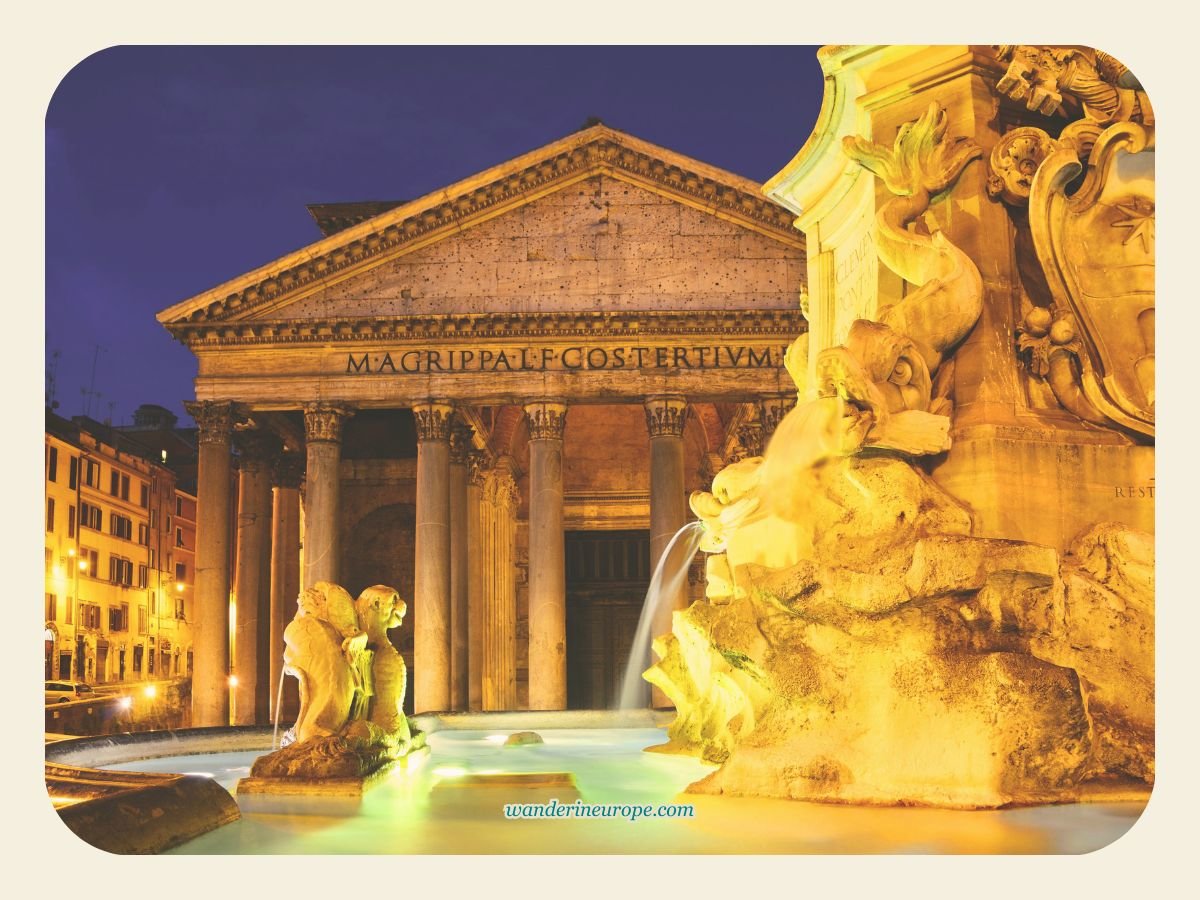
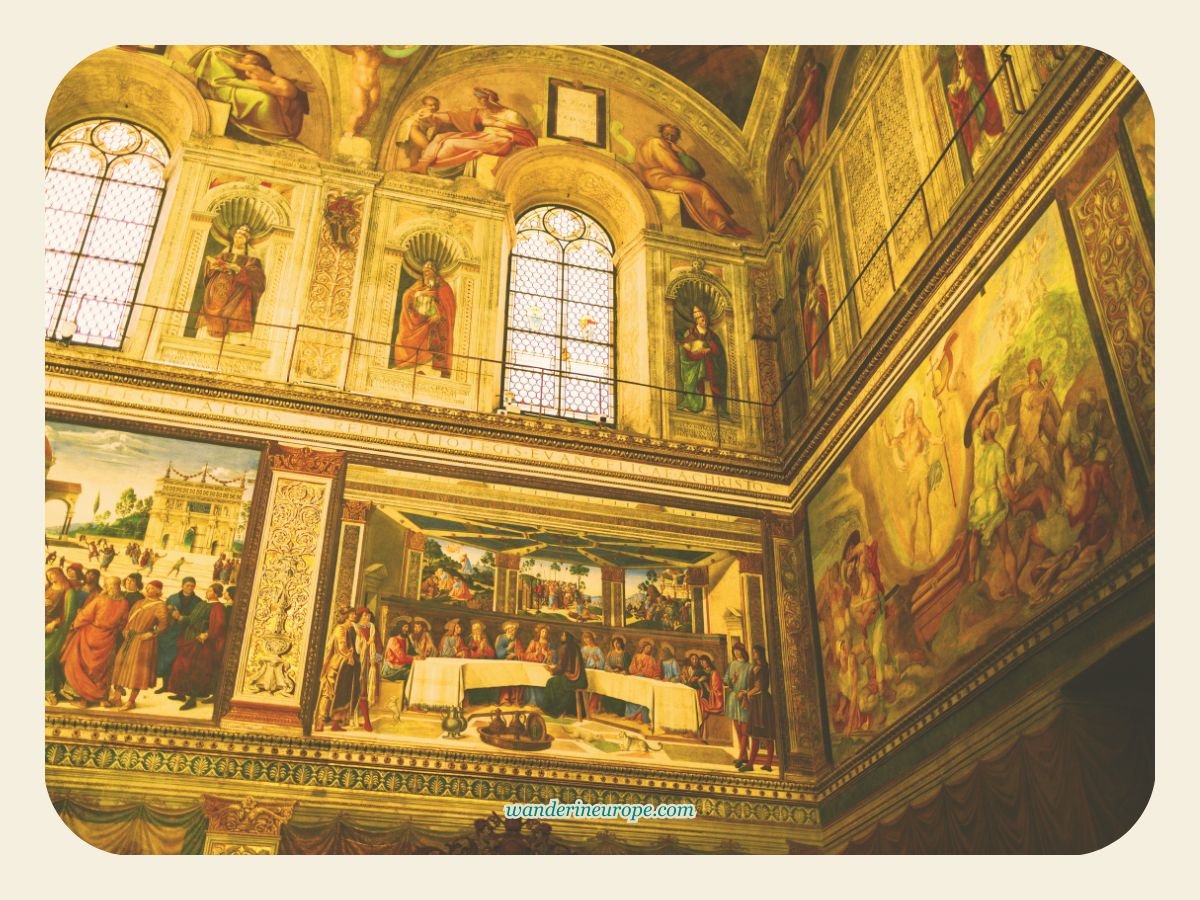

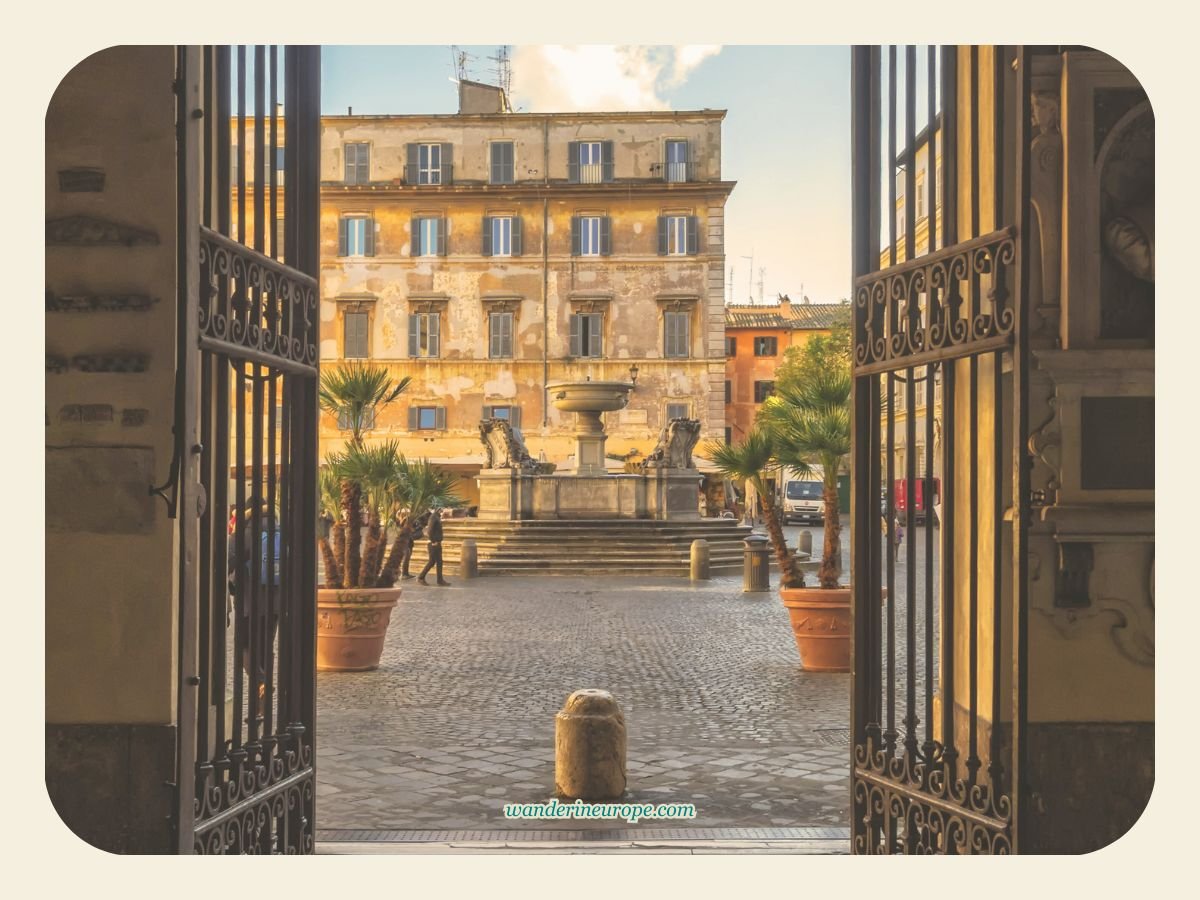
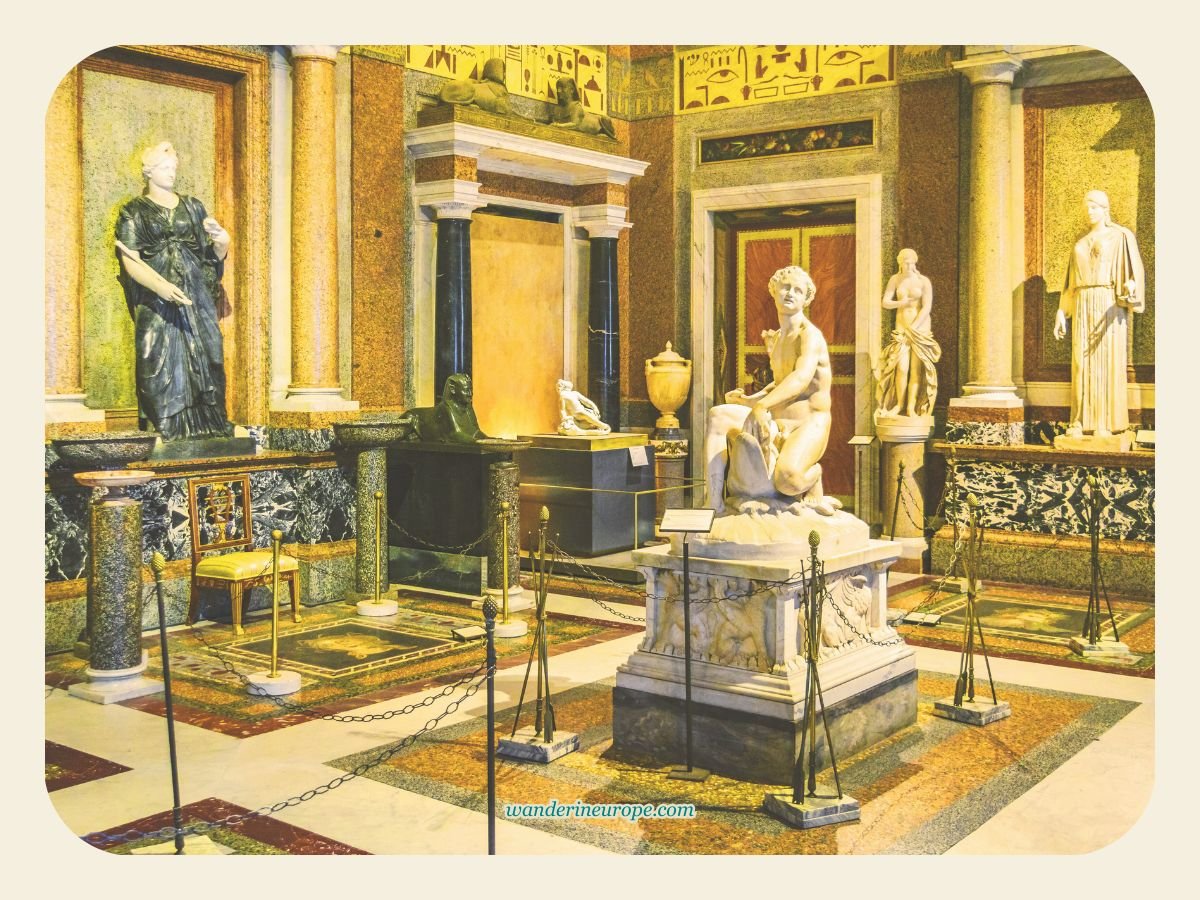
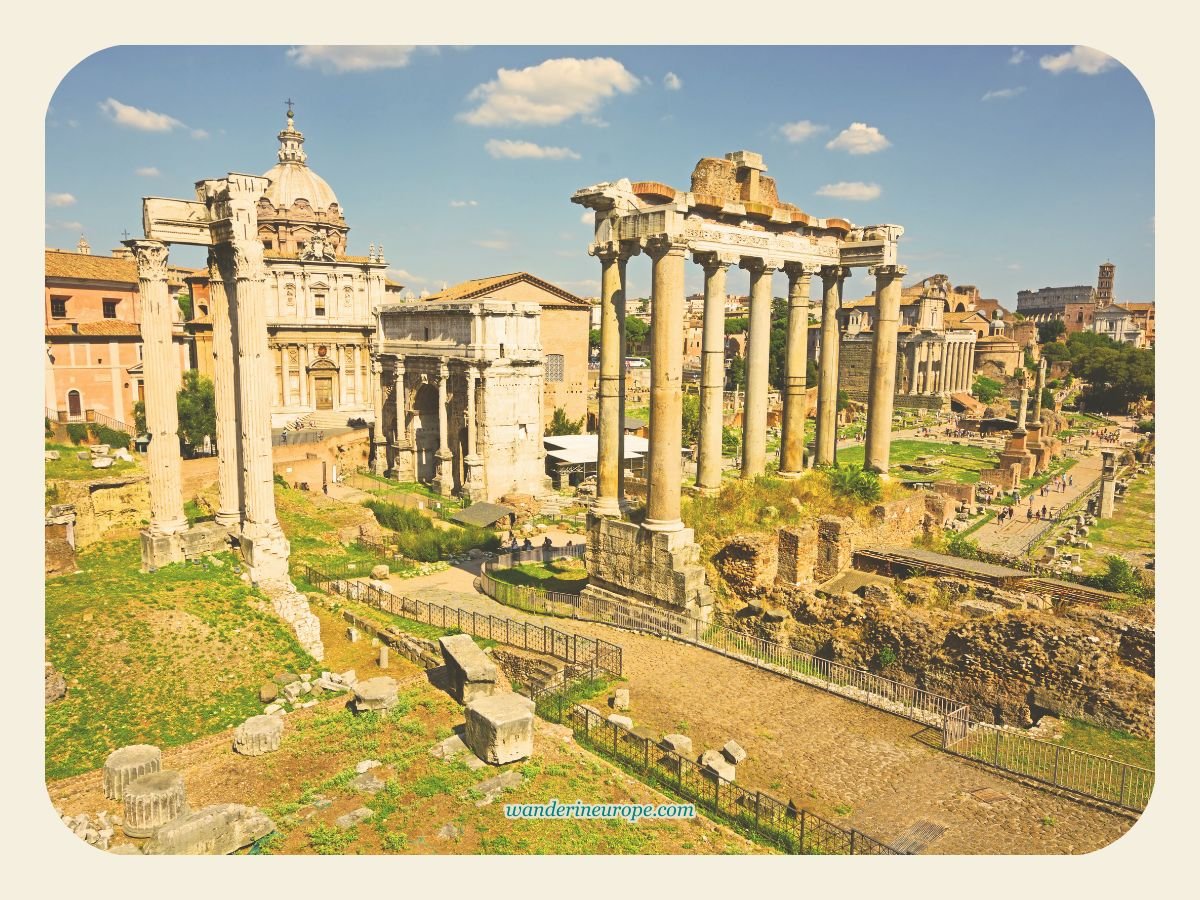

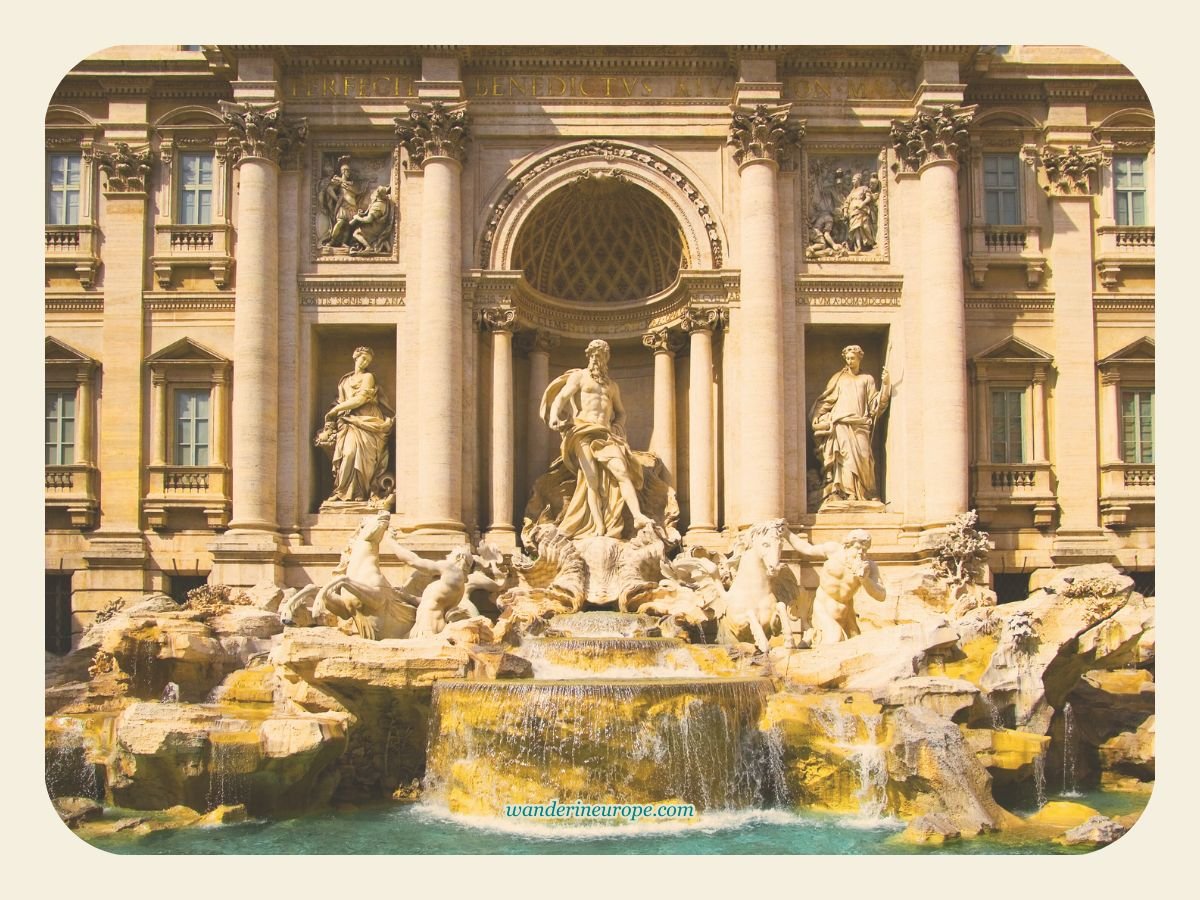

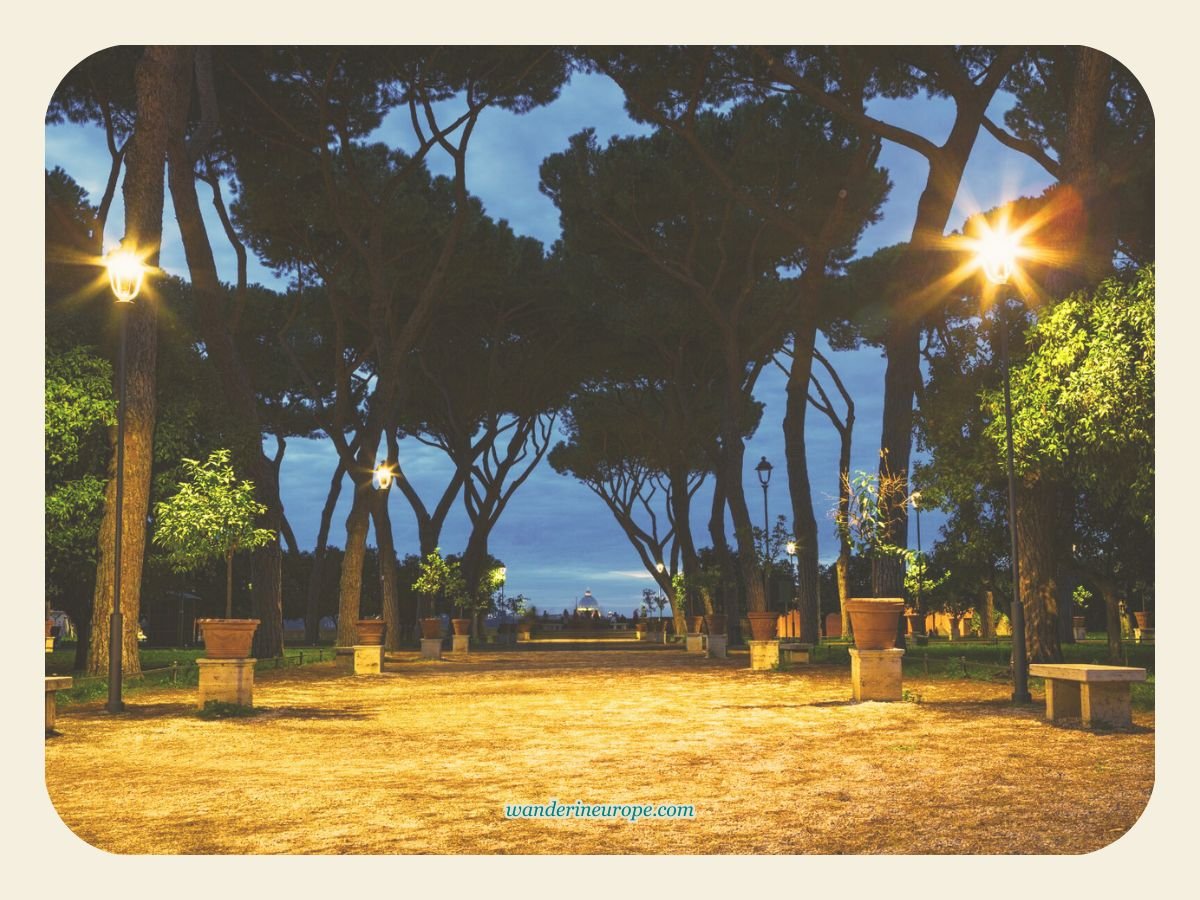

Intrigued? Let me share their background and some fascinating details—hopefully, it inspires your wanderlust even more!
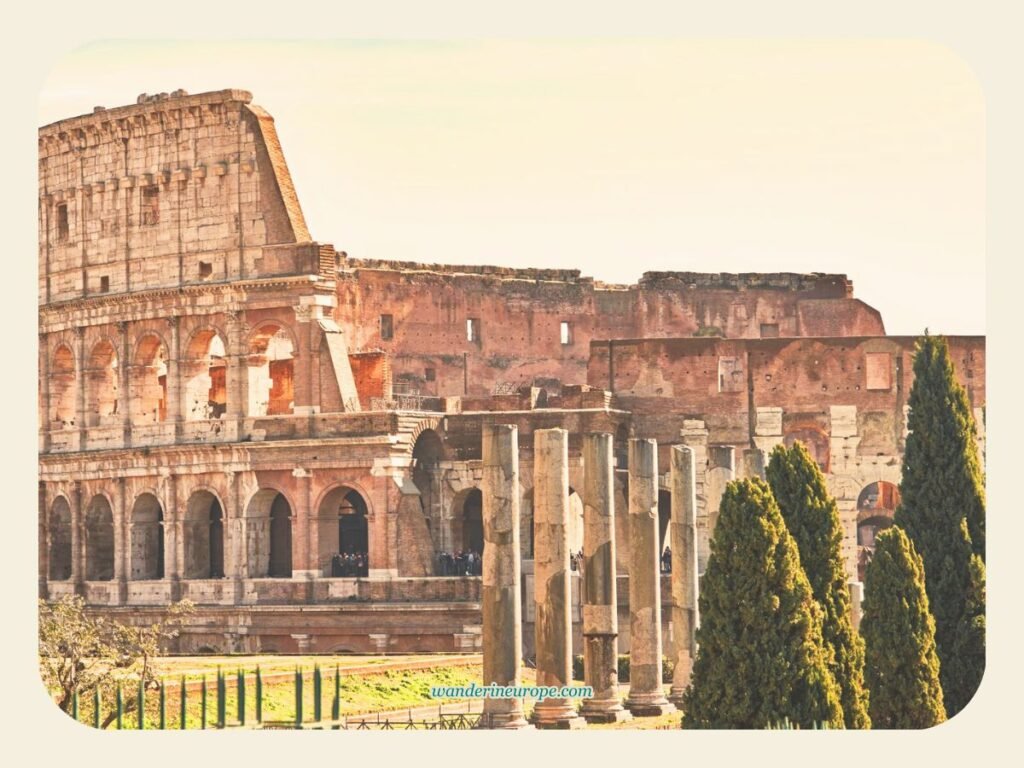
The Colosseum stands as a breathtaking reminder of Rome’s greatness, pulling us into its rich and fascinating history. It’s more than just a marvel of architecture and engineering that has withstood the test of time—it’s a symbol of Rome’s enduring power and influence.
Think about it: this massive structure, still standing strong after more than 2,000 years, was built entirely from stone and concrete. No modern technology, no steel reinforcements—just ancient ingenuity at its finest.
Step inside, and you’re transported back in time. The interior might not be the most visually striking, but every stone holds a story. Picture over 50,000 Romans packed into the stands, eagerly watching events that ranged from public executions to epic battles. Gladiators clashed, wild animals fought, and, incredibly, even naval battles took place here.
Yes, naval battles—right inside the Colosseum! The Romans somehow flooded the arena and brought in real ships for mock sea battles. Just imagine the effort it took to fill this enormous space with water. Where did they even get all that water? It’s a mystery that still amazes historians today.
From the outside, the Colosseum is just as impressive. Its towering walls and massive arches make it one of the most recognizable landmarks in the world. From a distance, the levels might look identical, but up close, you’ll see that each one has a unique design. The architects used three different styles—Corinthian, Ionic, and Doric—layered from top to bottom.
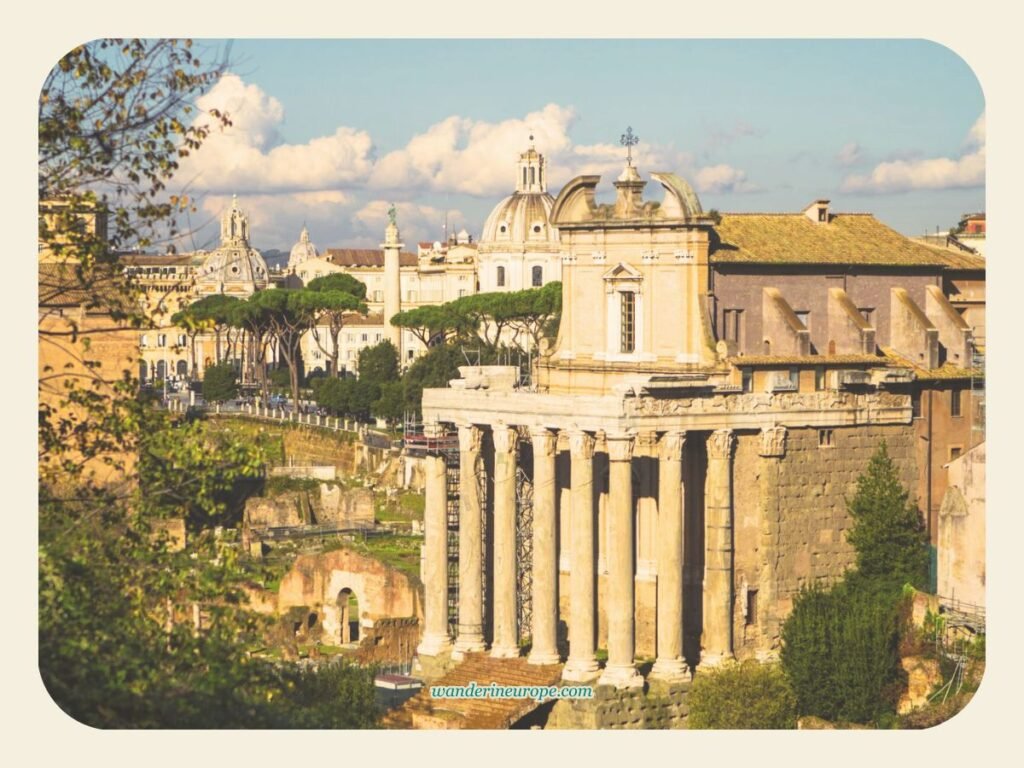
Just a short walk from the Colosseum, the Roman Forum was once the bustling heart of ancient Rome—a place where politicians gave speeches, merchants sold their goods, and citizens gathered for public events.
Today, it’s a sprawling archaeological site, but its ruins still tell the story of its grand past. As you explore, you’ll come across iconic landmarks like the Via Sacra, where victorious generals once marched, the Curia, where senators debated, and temples dedicated to Roman gods and emperors. To truly appreciate its history, check out this Ted-Ed video.
For the best view, head up to Palatine Hill, where you can take in the entire Forum, with the Colosseum rising to the east and the ruins stretching out toward the west.
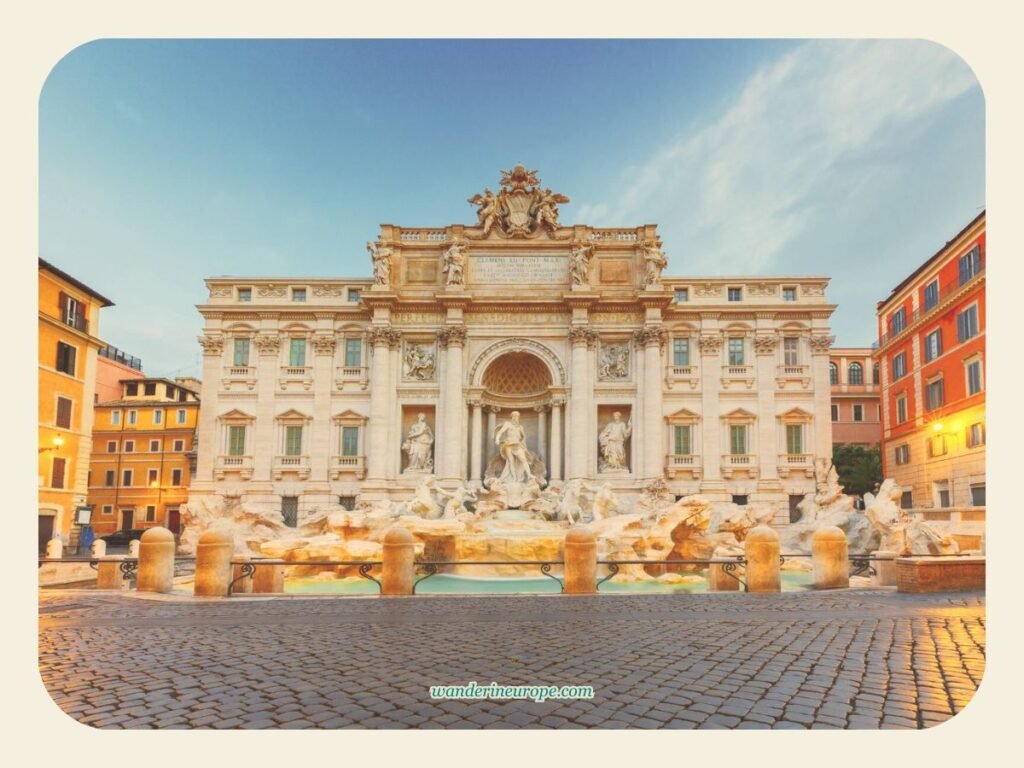
The Trevi Fountain is one of Rome’s most stunning landmarks that adds to the city’s charm and history. It stands at the meeting point of three streets—Poli Street, Delle Muratte Street, and De’ Crocicchi Street—which is how it got its name. “Trevi” comes from the Latin word Trivium meaning “three streets.”
This breathtaking fountain rises 26 meters (85 feet) high and stretches 49 meters (161 feet) wide, making it a true masterpiece. Since 19 B.C. it has supplied water to Rome’s residents and continues to captivate visitors with its artistic grandeur. At the top stands a statue of Oceanus, the god of all water, riding a chariot pulled by seahorses. The fountain is made primarily of Travertine, the same stone used to build the Colosseum, and is set against the elegant Palazzo Poli to create a postcard-perfect view.
Beyond its beauty the Trevi Fountain is also famous for its tradition. Legend has it that tossing a coin into the water ensures your return to Rome. Throw in two and love is in your future. Three? Wedding bells might be on the way. Whether you believe in the legend or not it’s a fun way to take part in Roman culture and maybe, just maybe, bring a little luck your way.
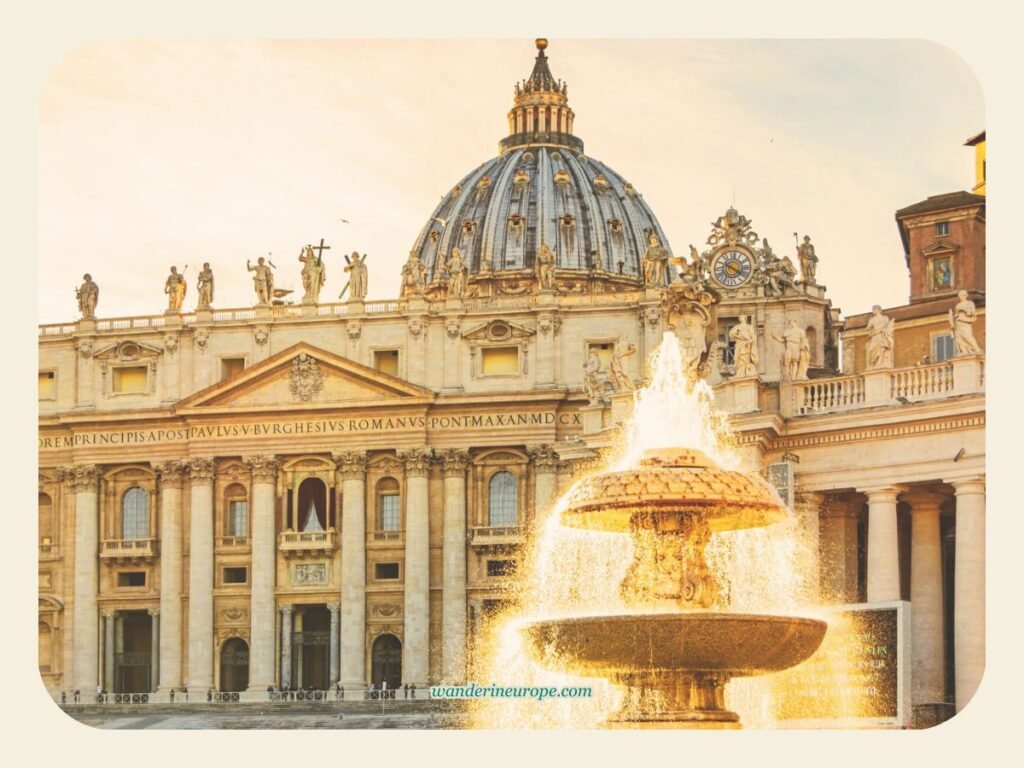
Although Saint Peter’s Basilica isn’t technically in Rome, it’s surrounded by the city and was once part of it, so it still feels like an essential part of Rome’s identity. Its massive size and priceless religious artifacts make it one of the most breathtaking landmarks in the world, holding deep significance not just for Catholics but for anyone who appreciates art, history, and human achievement.
The basilica itself is a Renaissance masterpiece, brought to life by legendary architects like Carlo Maderno, Gian Lorenzo Bernini, Donato Bramante, and, most famously, Michelangelo. Everywhere you look, there’s something incredible to admire—ornate walls, towering bronze doors, and awe-inspiring ceiling paintings.
Inside, you’ll find some of the most treasured works of art, including Michelangelo’s La Pietà, the revered bronze statue of Saint Peter, and Bernini’s magnificent Baldacchino. Even if you’re not religious, visiting Saint Peter’s Basilica feels like stepping into a place that shaped civilization itself.
And for those who believe, like I do, it’s more than just a beautiful sight—it’s a deeply moving and unforgettable experience.
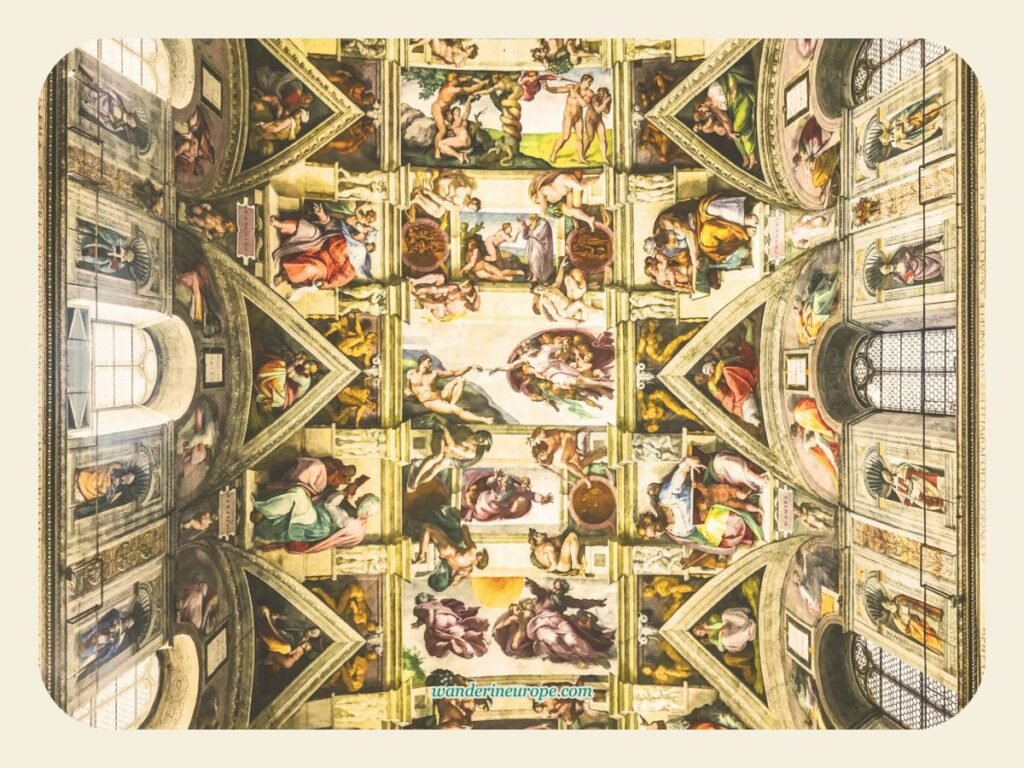
If you want to witness beauty that’s truly beyond words, the Sistine Chapel is the place to be. Located in the Vatican, this historic chapel might look simple from the outside, but once you step in, you’ll be amazed.
Built in the late 1400s by Giovanni dei Dolci for Pope Sixtus IV, the chapel is a masterpiece of Renaissance art. Not long after it was completed, top artists from Florence decorated its interior, creating some of the most celebrated paintings in Western history. The most famous of them all? Michelangelo’s ‘Creation of Adam’—the iconic image of God reaching out to touch Adam’s hand.
But that’s just one of many breathtaking works inside. The walls and ceiling are covered with vivid paintings that bring Old Testament stories to life and depict the Last Judgment. Visiting the Sistine Chapel isn’t just about admiring incredible art—it’s also about stepping into a place of great significance for the Catholic Church.
This is where the Sacred College of Cardinals meets to elect a new pope whenever the position becomes vacant. The Sistine Chapel is indeed a part of what makes Rome such an unforgettable destination.
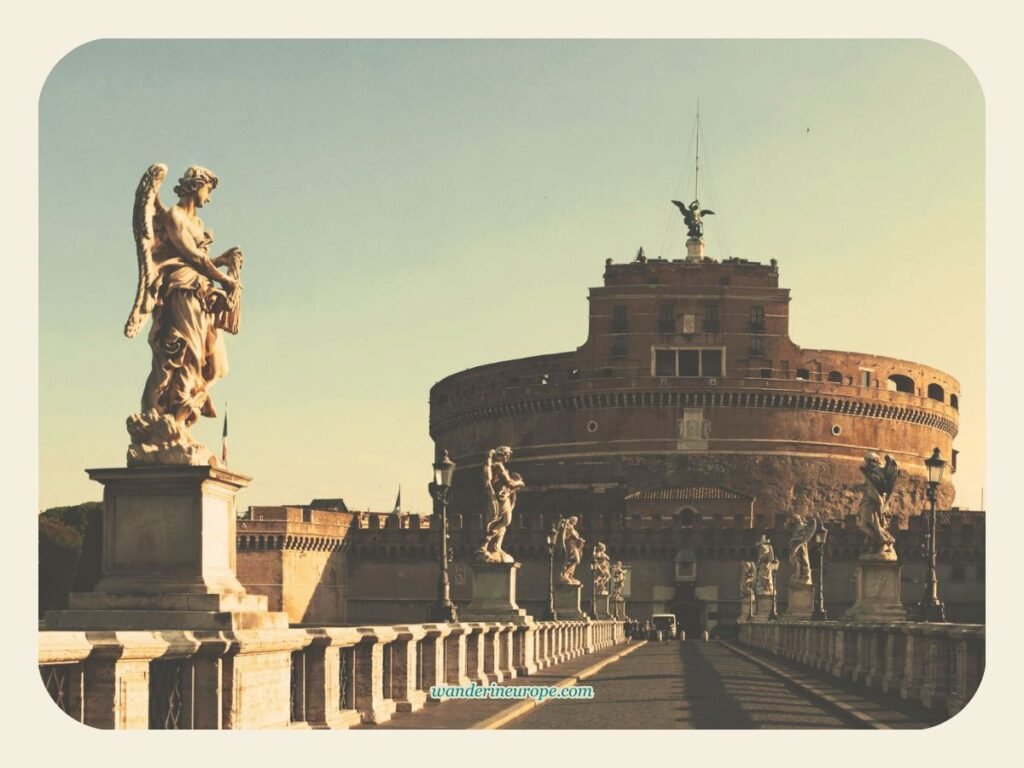
Castel Sant’Angelo, or the “Castle of the Holy Angel,” is one of Rome’s iconic landmarks.
This unique cylindrical fortress gets its name from a marble statue of Archangel Saint Michael, placed on top by Pope Gregory the Great after he had a vision of the angel ending a plague in Rome. While it later served as a refuge for popes during wars and conflicts, its original purpose was as a mausoleum. Between 134 and 139 AD, Emperor Hadrian commissioned it as a burial site for himself and his family, which is why it is also known as the Mausoleum of Hadrian.
Castel Sant’Angelo sits just west of Vatican City, next to the Tiber River. Its strategic location made it an ideal fortress, and about five centuries after it was built, the popes converted it into a military stronghold. In the 14th century, Pope Nicholas III even added a fortified corridor, the Passetto di Borgo, linking it to Saint Peter’s Basilica. This passage proved invaluable in the early 16th century when Emperor Charles V of the Holy Roman Empire invaded Rome.
Visiting Castel Sant’Angelo feels like stepping back in time. You can explore the ancient mausoleum, walk through rooms once used by popes, and see the fortified corridor, along with various historical artifacts on display. The castle’s massive size, distinctive battlements, and towering ramparts—best seen from Ponte Sant’Angelo—set the scene for a medieval experience before you even step inside.
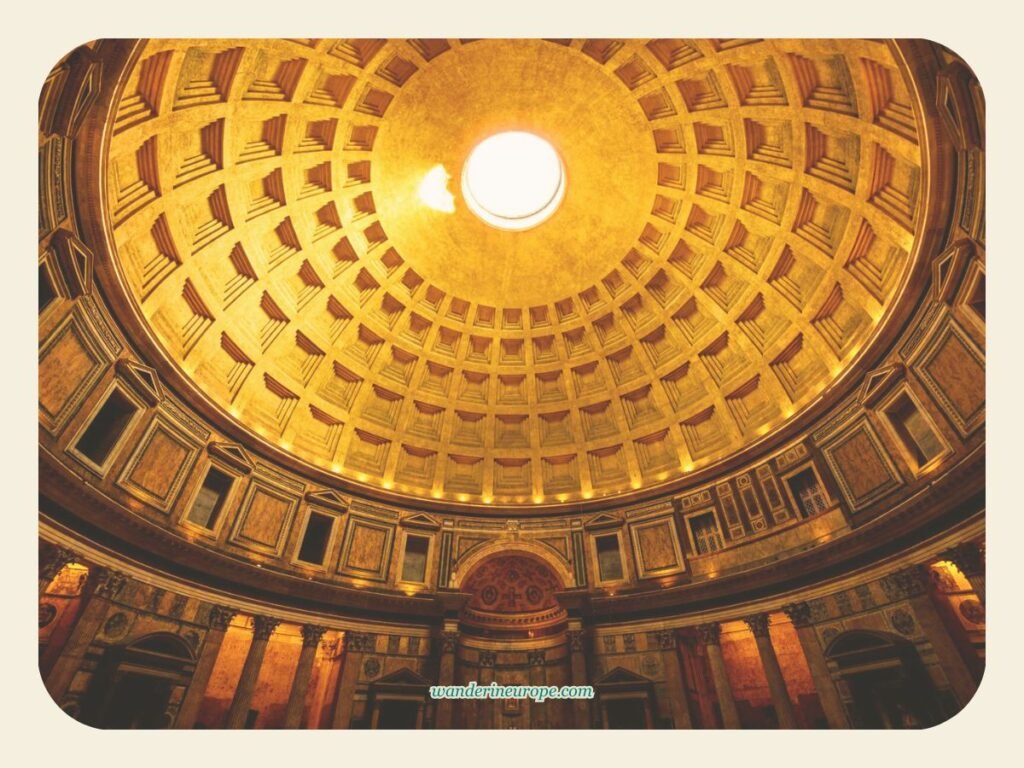
Besides the Colosseum, Rome’s beauty is also highlighted by the Pantheon, an ancient architectural marvel.
The original Pantheon was built in 25 B.C. by the Roman statesman Marcus Agrippa. After multiple fires destroyed it, Emperor Hadrian completely rebuilt it in 128 A.D. Initially a pagan temple, the Pantheon—its name derived from Greek words meaning “all gods”—was later converted into a Christian church as the Roman Empire adopted Christianity. In 609, Pope Boniface IV renamed it the Basilica of St. Mary and the Martyrs.
The most remarkable feature of the Pantheon is its massive dome, the largest unsupported dome in the world.
It’s so big that a 43-meter-wide sphere could fit perfectly inside. On a clear day, when the sun is directly overhead, sunlight pours through the oculus—the “eye” of the Pantheon—at the top of the dome. The dome’s perfect proportions, immense size, and elegant design, combined with the dramatic play of light from the oculus, make it a breathtaking sight. The engineering behind the Pantheon is nothing short of extraordinary, solidifying its place as a true architectural marvel.
Among all the ancient Roman structures, the Pantheon is the best-preserved, largely because it has been in continuous use. It functions as both a church, where the Holy Eucharist is celebrated, and a burial site for many of Italy’s great poets, kings, and artists, including Raphael.
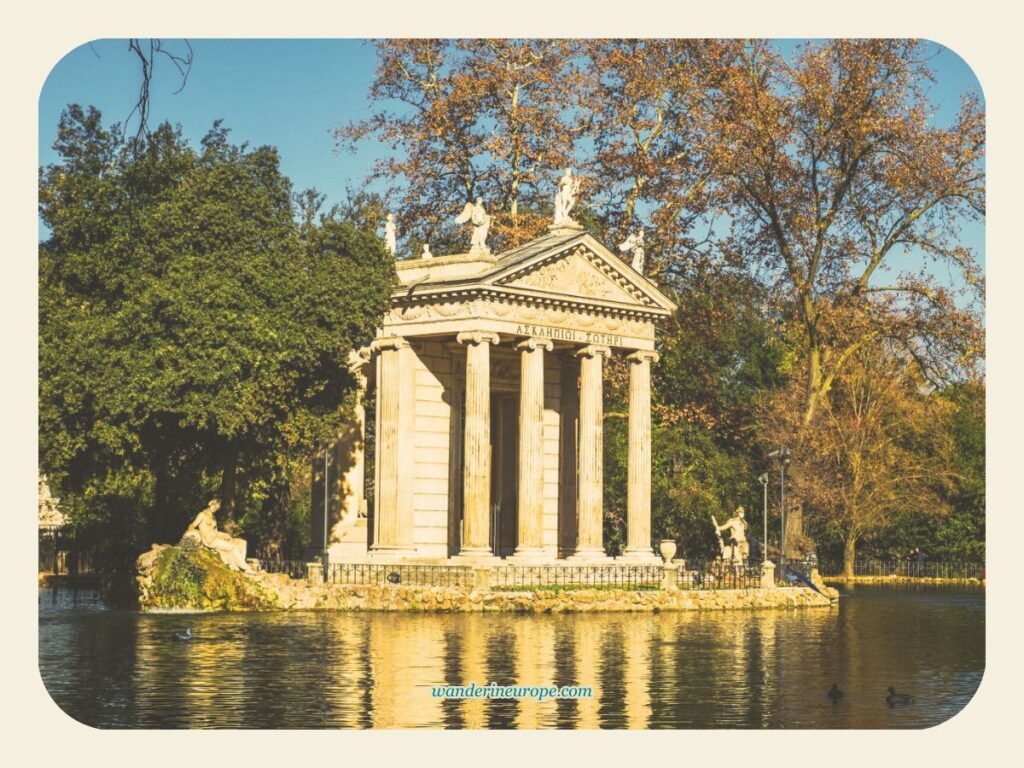
Rome’s charm isn’t just about its beauty—it’s also about romance, and Villa Borghese is a perfect example. As the third-largest park in the city, it spans 80 hectares (about 198 acres) and offers a mix of museums and romantic activities, making it a place that truly steals the heart.
The highlight of Villa Borghese is the Borghese Gallery, home to masterpieces by some of history’s most influential artists. Here, you’ll find everything from ancient Roman artifacts to stunning Renaissance works. Notable pieces include Bernini’s breathtaking sculpture Apollo and Daphne and Titian’s famous painting Sacred and Profane Love. The gallery also features works by Raphael and Caravaggio, showcasing incredible detail, especially in Bernini’s marble sculptures.
The romance doesn’t end at the gallery. Step outside, and you’ll find beautiful gardens, peaceful ponds, and even cozy cinemas perfect for a romantic outing.
Want a dreamy experience on the water? Rent a boat and drift along the pond, taking in the scenic views, including a charming old-style temple near the shore. Thinking about the perfect place to propose? Head to the Pincio Terrace, the most picturesque spot in the villa. This spacious plaza features a balcony overlooking the city, becoming especially magical from golden hour to dusk as the city lights begin to twinkle.
Looking for more romance? In the summer, Casa del Cinema, an arthouse theater in Villa Borghese, hosts free outdoor movie screenings. Snuggle up and enjoy a film under the stars!
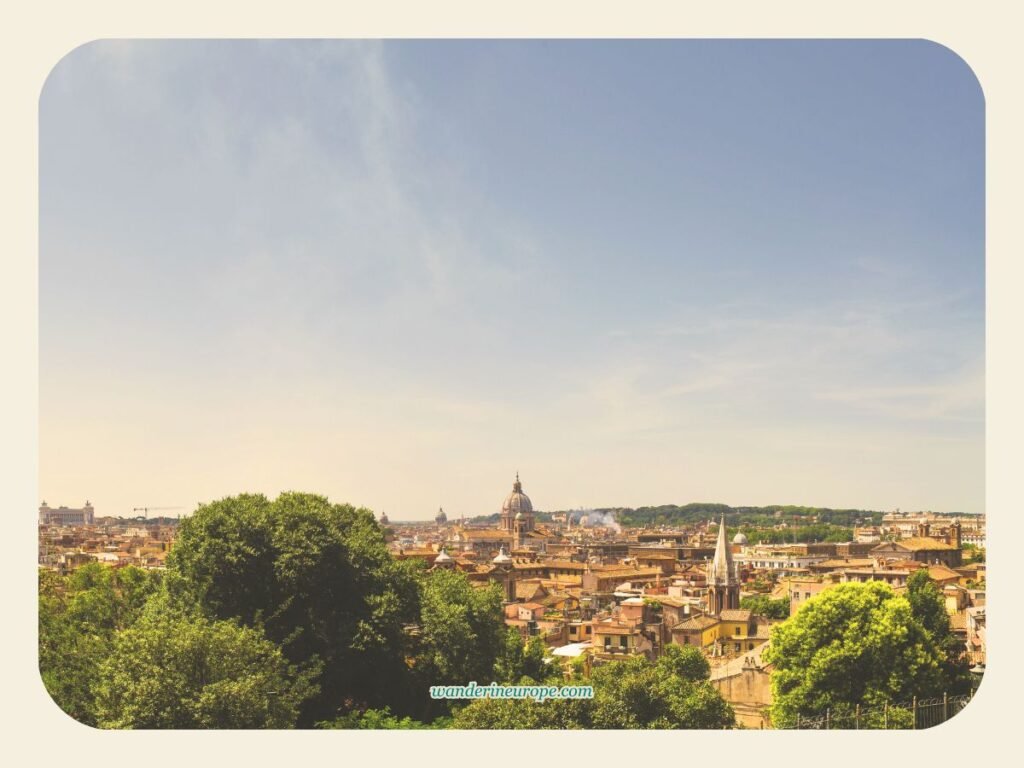
Another beautiful spot in Rome is Giardino degli Aranci, or the Orange Trees Garden. It’s especially stunning at sunset, during the golden hour. While it offers a city view similar to Villa Borghese, I find it even more picture-perfect. Its unique location and layout set it apart.
Sitting atop Aventine Hill with a direct view of Vatican City, the garden provides a breathtaking perspective of Rome’s skyline. Designed by Raffaele de Vico, it was intentionally arranged to highlight the dome of Saint Peter’s Basilica as the focal point.
The breathtaking city view isn’t the only reason Giardino degli Aranci is a must-visit in Rome. The garden itself is beautifully designed, with a central path that perfectly aligns with the city’s skyline. Lined with orange trees, this path creates a stunning scene, especially at sunset when the trees cast shadows against the colorful sky.
If Rome is on your travel list, Giardino degli Aranci is the perfect place to unwind after a busy day of exploring. Plus, it’s completely free to visit.
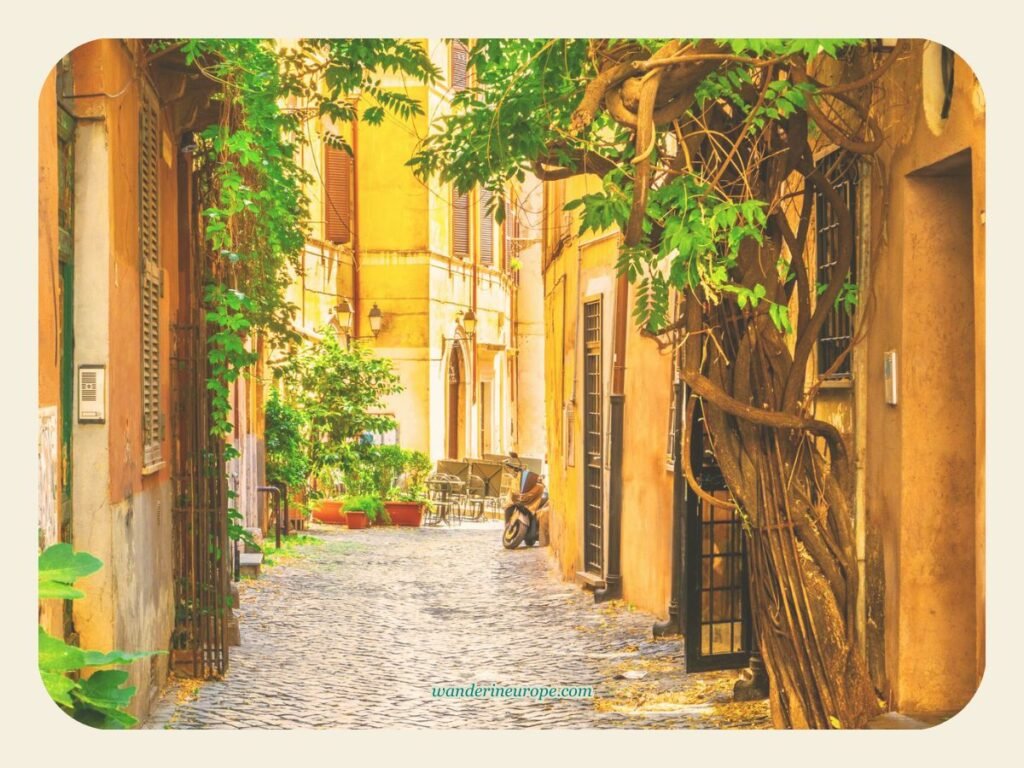
Finally, there’s Trastevere, Rome’s 13th district, located just west of the historic center. This neighborhood is famous for its many restaurants and pubs, making it a go-to spot for both locals and tourists looking for a fun night out. But Trastevere isn’t just about nightlife—it also offers some of the most picturesque views in Rome. With its narrow, cobblestone streets and charming old houses, it’s the perfect place to soak in the city’s timeless beauty.
Some buildings are covered in ivy, adding to the neighborhood’s old-world charm. Trastevere is also less crowded than the city center, making it a great place to wander and explore. On top of that, it’s home to some unique attractions you might not expect—like a Japanese garden with bamboo groves and waterfalls!
Other must-see spots in Trastevere include the Basilica of Santa Maria, a 3rd-century church in Piazza Santa Maria, famous for its breathtaking interiors. There’s also Villa Farnesina, a beautiful mansion decorated with stunning frescoes by Raphael, and Palazzo Corsini, a grand Baroque palace featuring impressive collections of Renaissance and Baroque art.

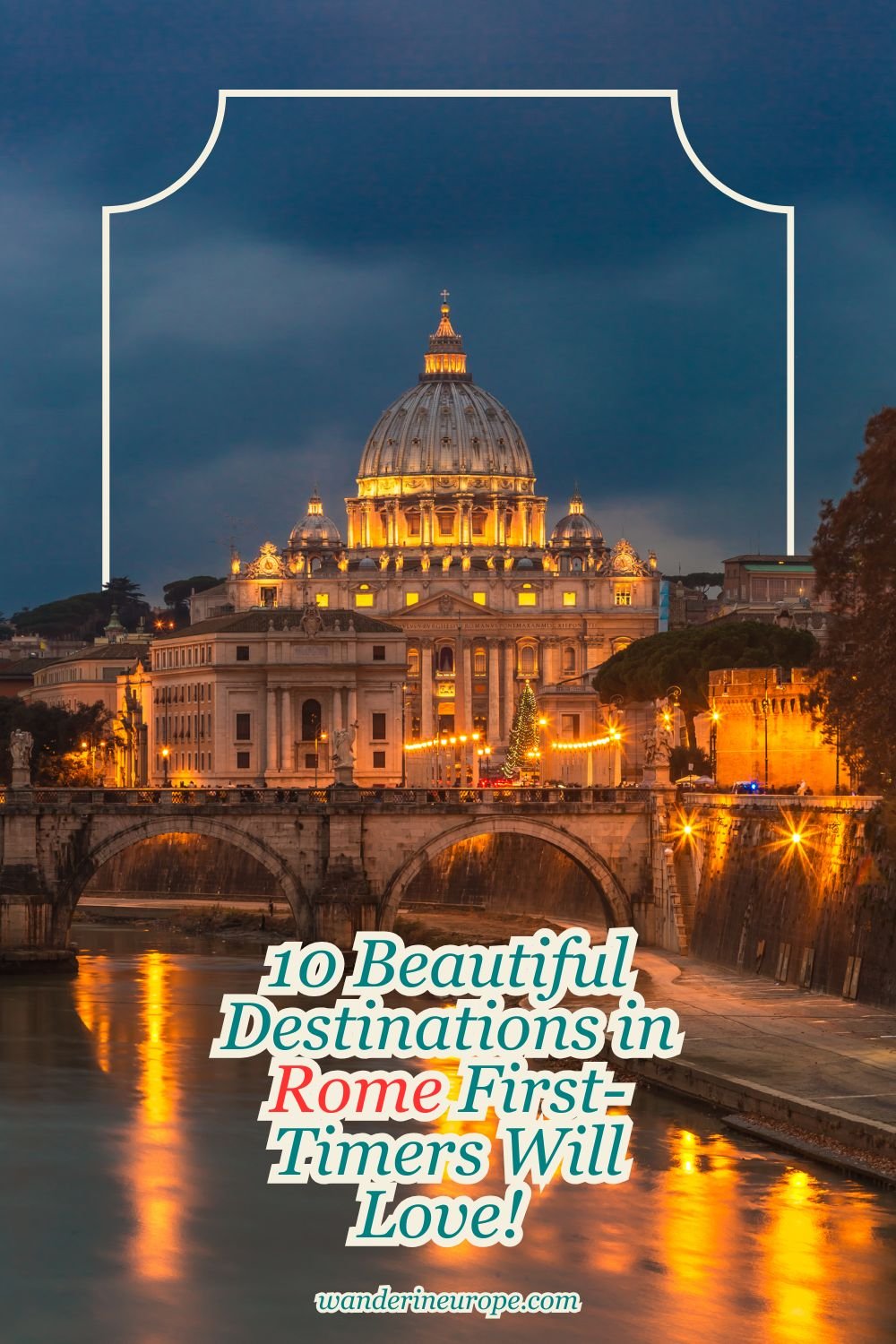
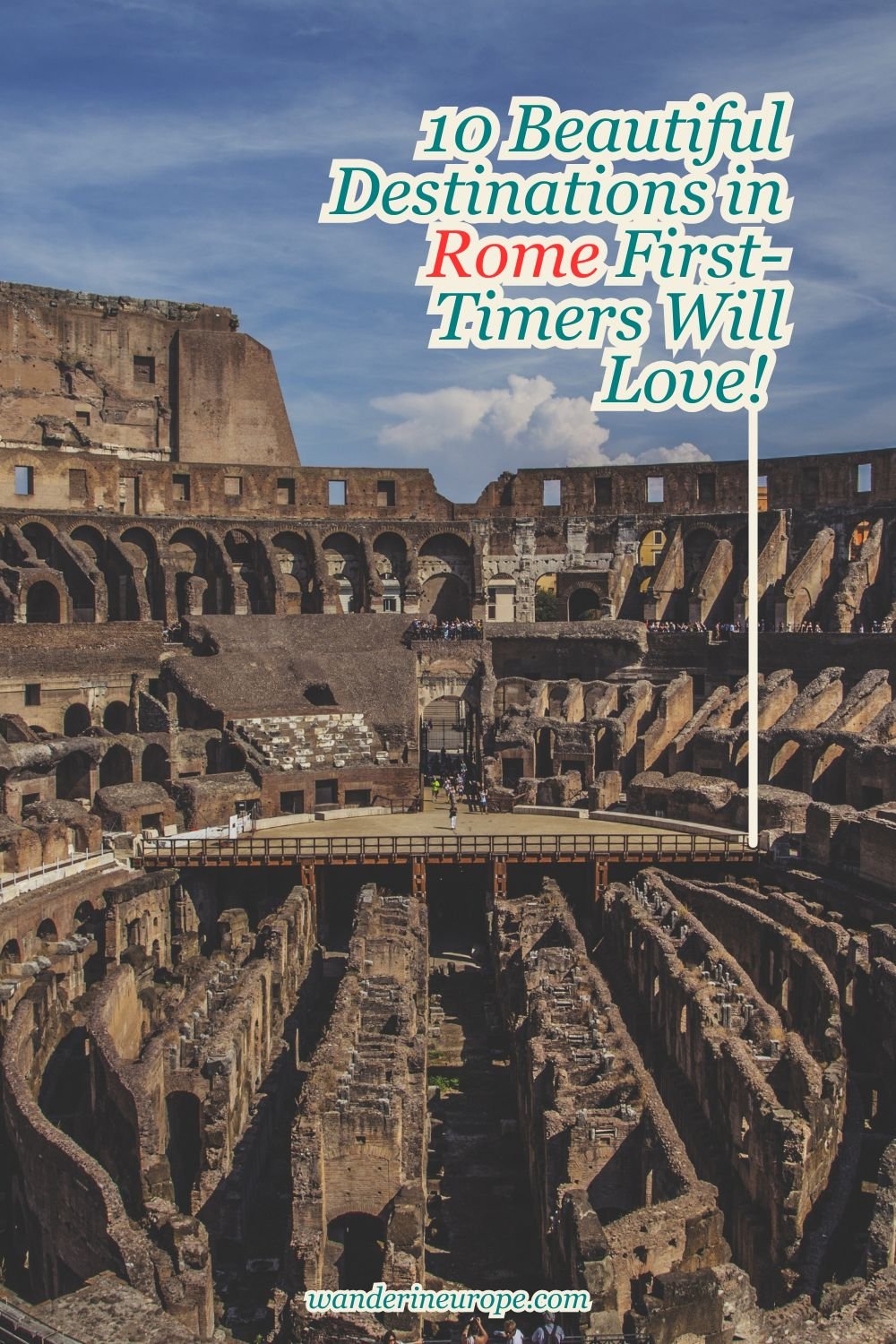
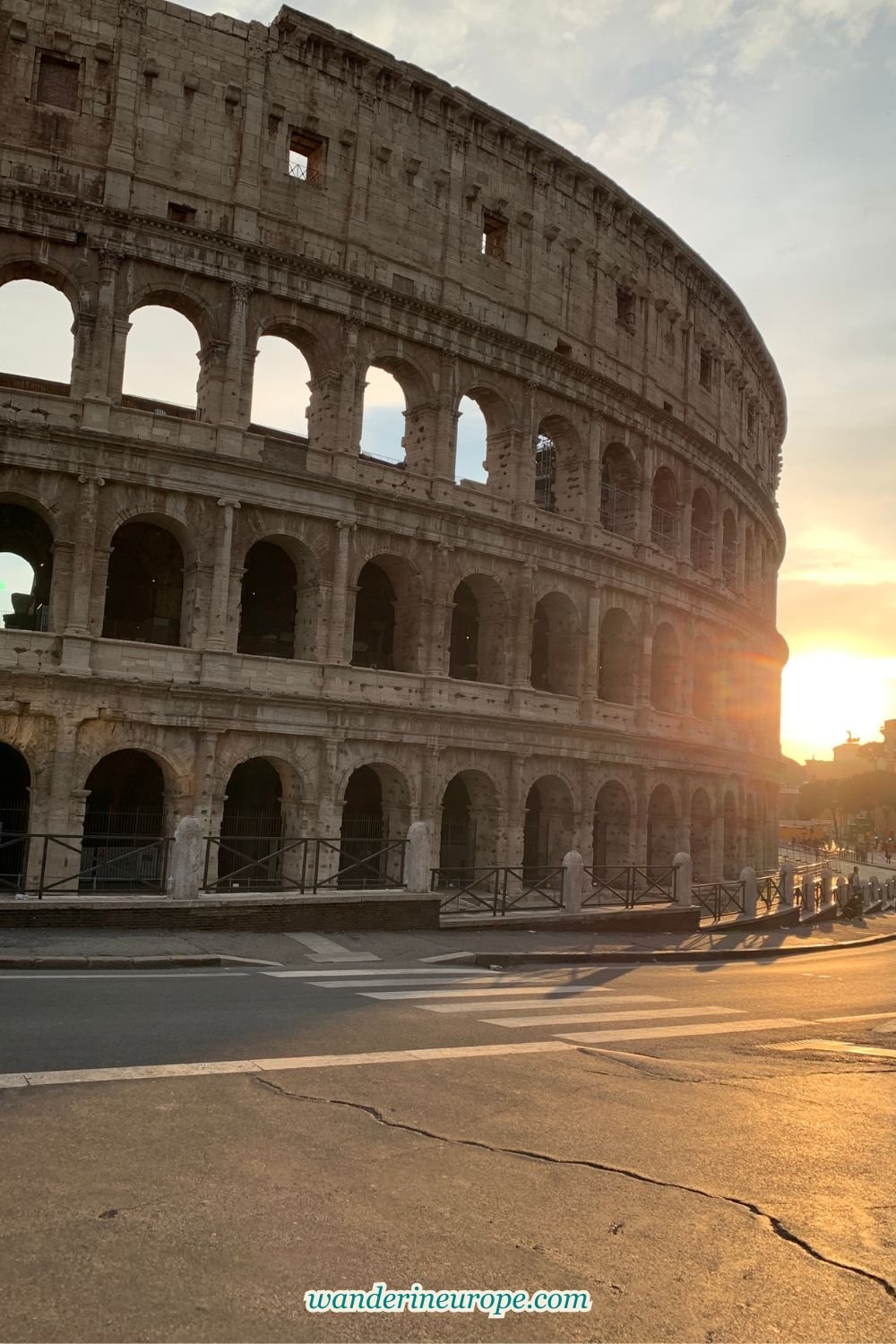
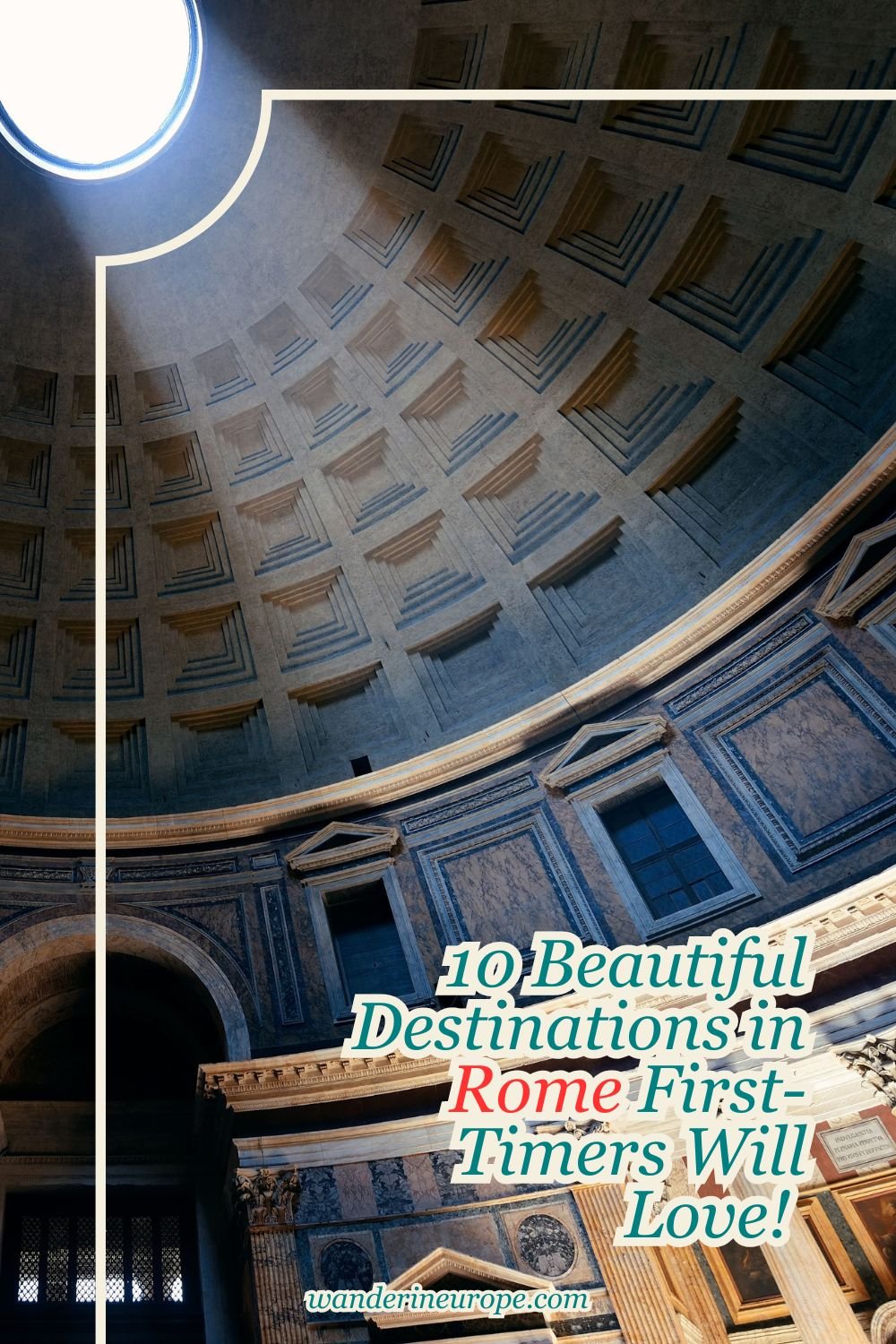
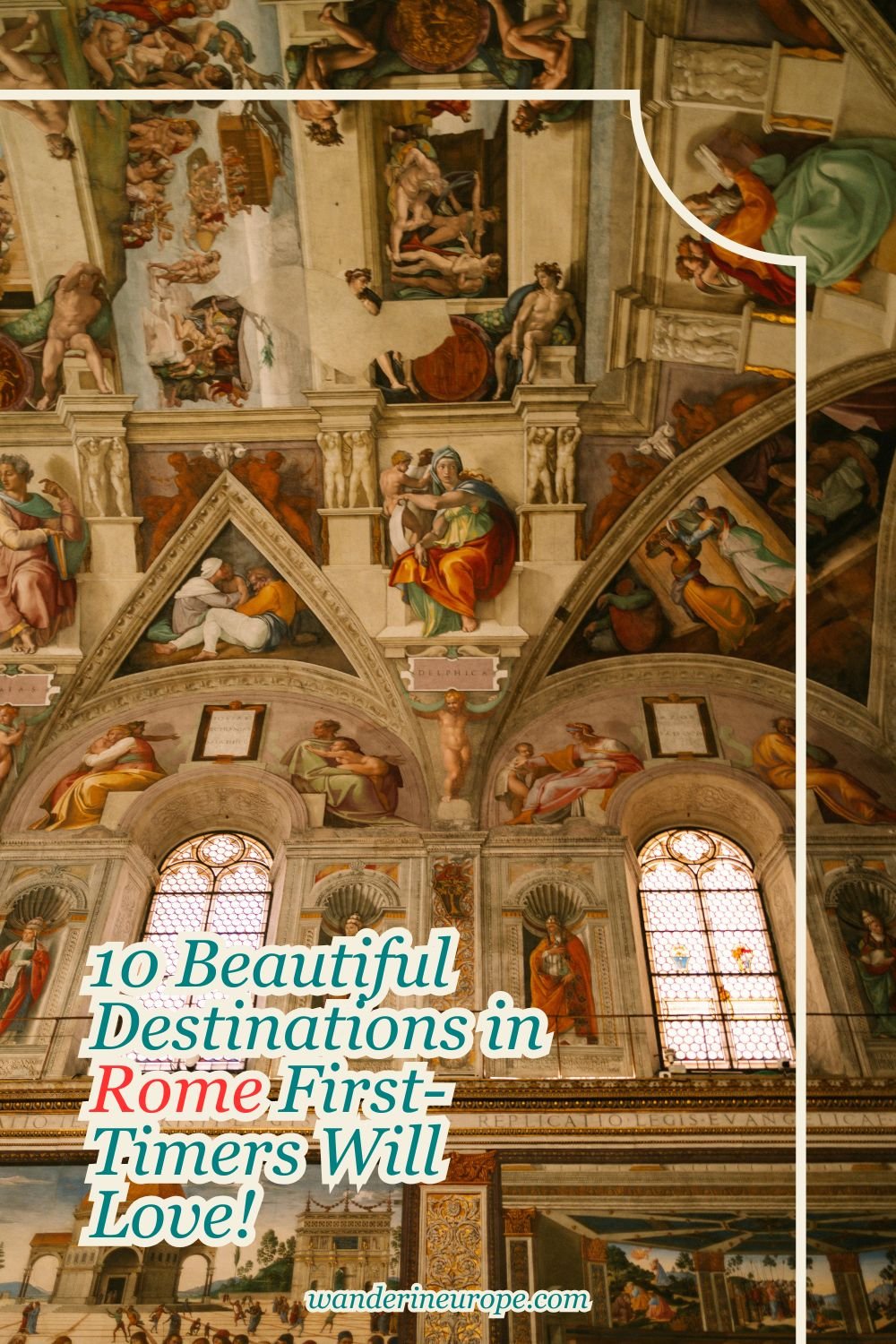
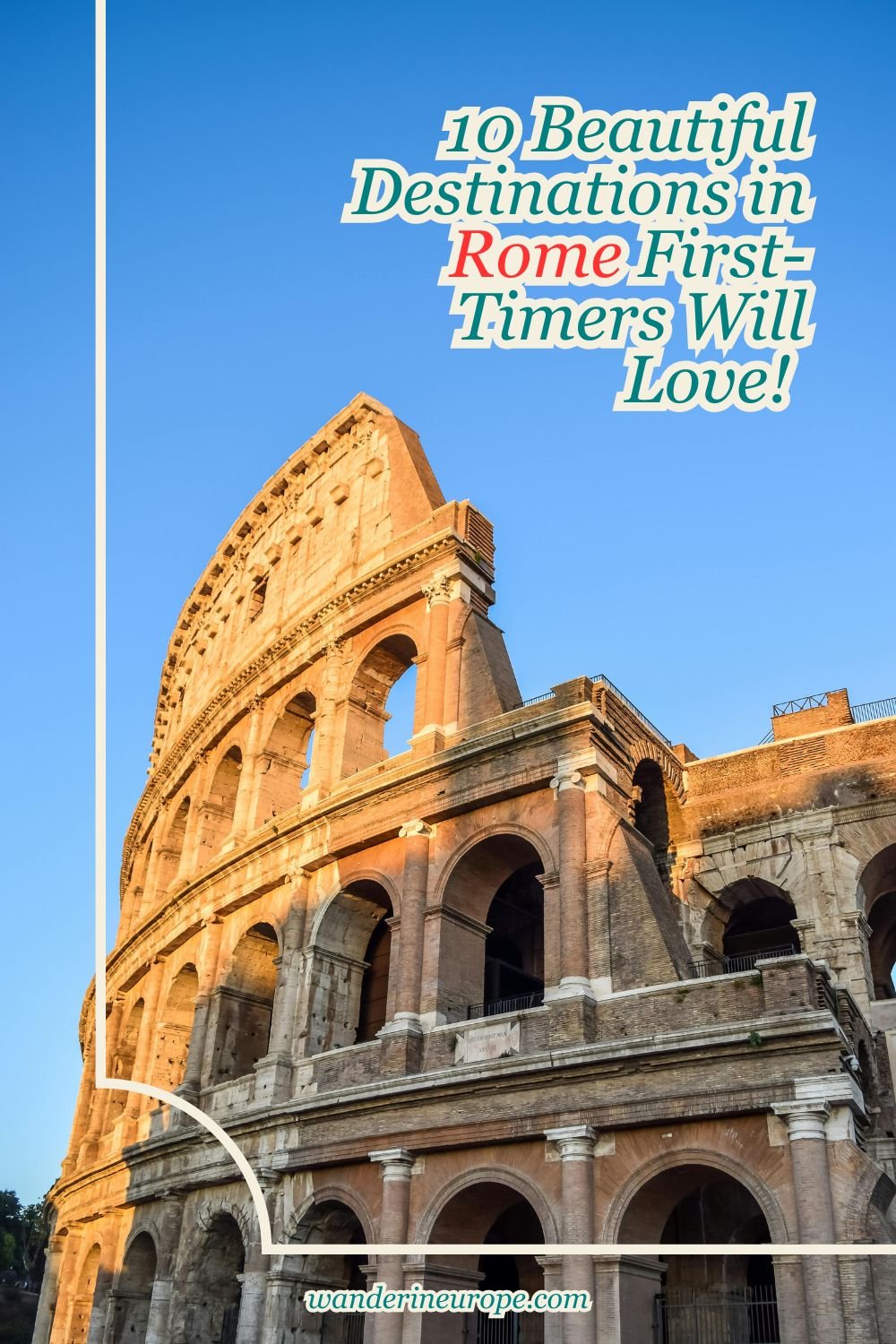
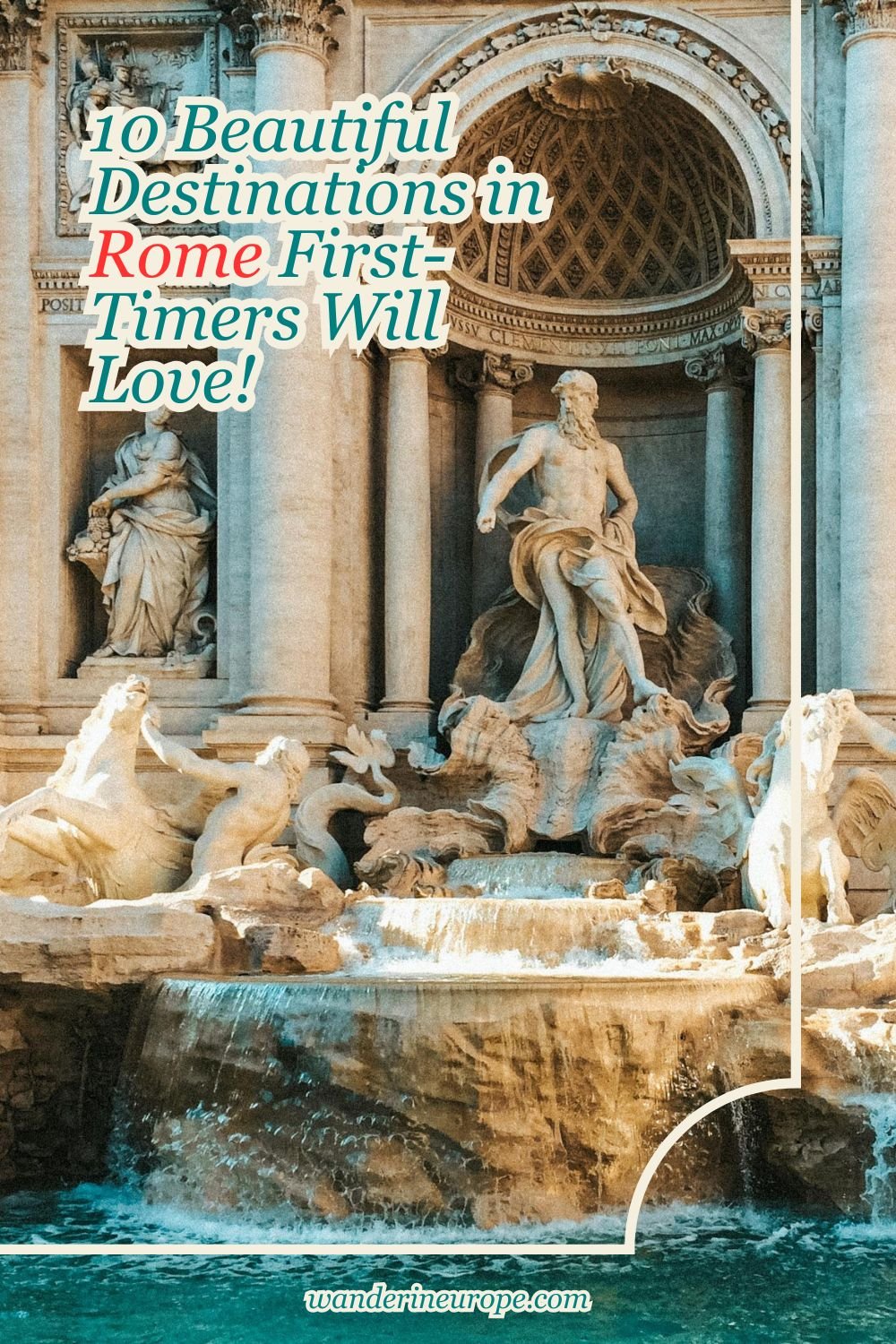
Pin this to save it for later or bookmark it to read anytime.

Head North from Rome
From Rome, you can start exploring Northern Italy, one of the most beautiful regions in Europe. This area has it all—stunning beaches, charming historic cities, and breathtaking alpine mountains. There’s nothing more you could ask for! Check out my Northern Italy bucket list to see just how incredible this region is.
Make your trip even more fun and hassle-free.
Plan Your Trip Now
WanderInEurope partners with trusted companies to make your trip unforgettable.
- Great Accommodation Deals (Booking.com)
- Cheap Car Rental (Rental Cars)
- Convenient Airport Transfers (Holiday Taxis)
- Public Transpo Ticket Reservation — Train, Ferries, Flights & More (Omio)
- Amazing Guides, Tours, & Transfers (GetYourGuide)
- Skip-The-Line Admission Tickets (Tiqets)
- Travel Insurance (Visitor’s Coverage)
- Luggage Storage (Radical Storage)
- Affordable Motorcycles & Bicycles Rental (Bikes Booking)
- eSim (Internet Virtually Everywhere) (Airalo)
Support WanderInEurope by using my recommended services above. The links are affiliate links, which means I earn a small commission when you make a purchase—at no extra cost to you. It’s like giving a free donation to help WanderInEurope keep creating helpful travel guides. Thanks for your support!
